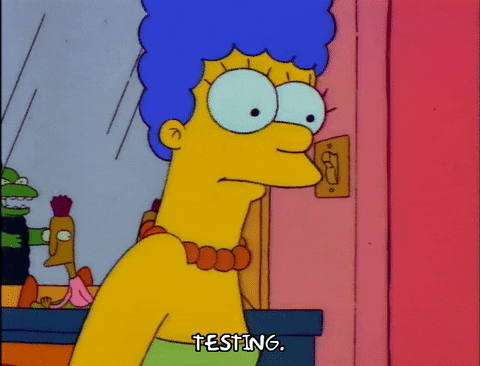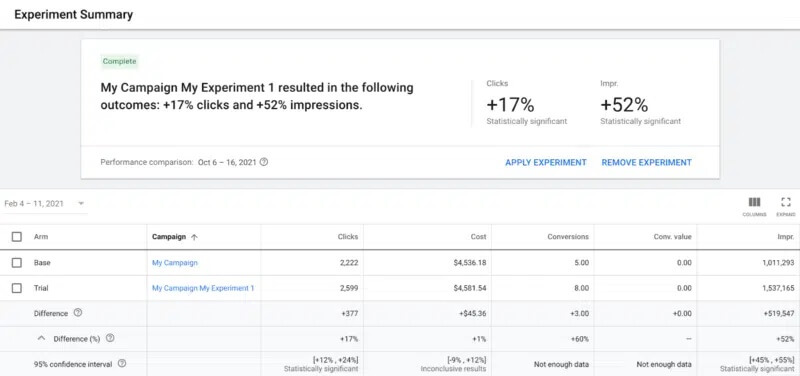After several years of managing client’s PPC campaigns, I've often found myself facing situations that feel irritatingly reminiscent of my struggles in everyday life––more specifically, the paralysis onset from an impending decision.
For example, my boyfriend Tom and I have discussed getting engaged for more than a year now. What’s the holdup, you ask? You’d think it would be the lifelong commitment to another person, but luckily that’s actually one of the easier decisions I’ve made. No, the holdup is…
THE RING.

I’ve spent more hours browsing jewelry sites and Pinterest boards than I care to admit, which only seems to make the decision more excruciating. How can I decide on THE ring when there are seemingly endless shapes, styles, settings, and gemstones?

Luckily, unlike ring shopping, the thing that makes decisions infinitely easier in the Google Ads realm (and our marketing efforts in general), is the ability to perform an A/B split test.
Split testing, also known as A/B testing, is a powerful tool for optimizing your marketing strategies, and helps you ensure that you’re making the best decision possible. It enables you to systematically test different versions of your website, content, and ad features, to see which performs better. Are you afraid to pull the trigger on an entirely new landing page? Test it! Your team can’t decide on which creative to use? Test it!
In this blog post, we will discuss some practical A/B testing examples and ideas that you can use to level up your Google Ads. We will also explain why it’s so important to use split testing for virtually all of your marketing efforts.
Why A/B testing is Crucial for Your Marketing Efforts
In today's competitive digital landscape, many businesses face the challenge of limited budgets and a lack of online presence. They need cost-effective marketing strategies that can generate maximum results––and this is where A/B testing comes in!

A/B testing, particularly in the context of Google Ads, allows you to optimize your marketing efforts and make data-driven decisions. By systematically testing different versions of your content, you can identify which elements resonate best with your target audience.
Google Ads A/B testing enables you to experiment with various ad copy, landing page designs, and ad targeting options. This allows you to find the winning combination that drives more clicks, conversions, and ultimately, revenue.
By utilizing A/B testing, business owners can make the most of their limited resources and ensure that every advertising dollar is spent wisely. This data-driven approach eliminates guesswork and helps refine marketing strategies over time. It identifies actionable insights into what works and what doesn't, and helps identify areas for improvement––an essential component in generating more leads and increasing conversions.
A/B testing Ideas for Ads
Creating compelling ad copy is essential for capturing the attention of your target audience and driving clicks and conversions. Here are some A/B testing ideas for your ad copy:
- Test different headlines: Experiment with various headlines to see which ones attract more attention. Try different formats, such as posing a question, making a bold statement, or offering a solution to a problem. The example below features two ads promoting the same sale using different headlines–Half Off vs 50% Off–to test if the language impacts engagement.

- Vary your call-to-action phrases: Test different CTA phrases to see which ones drive more clicks. For example, “Shop Now,” “Sign Up Today,” or “Learn More” are all common CTAs.
- Experiment with different ad descriptions: Try different lengths and styles of ad descriptions to see which ones resonate best with your audience. You can test longer descriptions that provide more detailed information or shorter ones that focus on key selling points.
- Use dynamic keyword insertion: Dynamic keyword insertion allows you to dynamically insert keywords from your ad group into your ad copy. Test using this feature to create more relevant and personalized ad experiences for your audience.
- Play with ad extensions: Google Ads allows you to include ad extensions that provide additional information or features. Test different types of extensions, such as sitelinks, callouts, or promotions, to see which ones improve click-through rates. The example below features two ads using different sets of sitelinks to test their impact on engagement.

A/B testing Ideas for Landing Pages
Landing page A/B testing is a crucial part of optimizing your Google Ads campaign. It allows you to test different variations of your landing page design and content to determine which one generates the best results. Here are some elements you can test on your landing pages:
- Test different headline variations: Experiment with different headline styles, lengths, and messaging to see which one captures the attention of your audience and encourages them to take action.
- Vary the layout and design: Try different layouts, color schemes, and visuals to see which one resonates best with your target audience. A small change in design elements can significantly impact user engagement and conversion rates.
- Test different calls-to-action: Experiment with different wording, color, size, and placement of your call-to-action buttons. Find out which one entices your visitors to click and convert.
- Play with content length and formatting: Test different lengths and formatting styles for your landing page content. Determine if shorter, concise content or longer, more detailed content performs better in terms of engagement and conversions. Play around with bulleted items vs. full paragraphs.
- Experiment with social proof and testimonials: Include customer testimonials or social proof on your landing pages to build trust and credibility. Test different types and placements of social proof to see which ones have the most positive impact on conversion rates.

- Compare service pages to dedicated landing pages: While it’s a Google Ads best practice to use a dedicated landing page (a page unique to Google Ads that can’t be accessed from anywhere else on your website), best practices don’t always equal best results! See how audiences respond to each type of page.
- Test out the presence of navigation links: Another best practice is to remove the navigation from Google Ads landing pages, giving your audience less opportunities to be distracted from completing your desired action––but test this to ensure this is effective on your specific audience(s).
A/B testing Ideas for Ad Targeting
Ad targeting plays a crucial role in the success of your Google Ads campaign. It allows you to reach your desired audience and increase the chances of conversions. Here are some A/B testing ideas for ad targeting that can help you optimize your Google Ads:
- Experiment with different audience segments: Create multiple variations of your target audience by adjusting demographics (age, location, income bracket), interests, and behaviors. Test different combinations to identify which segment generates the most engagement and conversions.
- Test different ad scheduling: Adjust the timing and frequency of your ad delivery. Experiment with running ads during different times of the day or days of the week to determine when your target audience is most active and responsive.
- Experiment with bidding strategies: Test different bidding strategies, such as manual CPC, target CPA, or maximize conversions. Adjust your bids based on the performance of each strategy to find the most cost-effective option that maximizes your ROI.
- Test your location targeting: Show your ads in different locations to see if your audiences behave differently in different zip codes, cities, states, etc.
How to Set Up an A/B test for Your Google Ads Campaign
- Determine an element from the list above that you’d like to experiment with. Once you’ve narrowed down your target, create multiple variations of that element.
- Set up your experiment directly in Google Ads or use a third party tool depending on your testing needs.
- Define your control group (which will receive the original version) and your experimental group (which will receive the variation). Make sure to randomize the distribution of your ads to ensure unbiased results.
- Set a clear objective for your test, whether it's increasing click-through rates, conversions, or revenue.
- Monitor the performance of your ads closely and gather data throughout the testing period.

Where to Find Your A/B Test Results in Google Ads
If you’re performing your test in Google Ads, the platform provides a simple dashboard within the “Experiments” tab that displays key metrics associated with your test. Here is an example of the results of an A/B test in Google Ads:

Google lets you know whether or not the results of certain metrics were statistically significant within the chart, but what determines whether your results were conclusive or not overall is based on the metrics you choose when setting up your test. In this case, the chosen metrics were clicks and impressions.
If the results were inconclusive, this message would be displayed instead:

Where to View Landing Page A/B Test Results in GA4
In the landing page report section of your GA4 account (under the “Engagement” tab), you can view data on your landing page performance, and adjust the columns in your report to reflect the specific metrics that are important to you. For example, in the screenshot below we were looking at two of our client’s ecomm landing pages and used average engagement time, events per session, views per session, add to carts, purchases, and total revenue to paint a full picture of how these pages are performing.

You can also use the date range selector to compare between different time periods––so if you didn’t perform a “true” AB test and just changed a page entirely, you can compare its performance before and after you made that change.
Tips for Interpreting A/B testing Results
Understanding and interpreting the results of your A/B testing is crucial to optimizing your Google Ads campaign. Here are some tips to help you make sense of your A/B testing data:
- Consider the sample size: The size of your sample can impact the reliability of your A/B testing results. Make sure you have a sufficient number of participants or data points to draw meaningful conclusions. Larger sample sizes generally provide more accurate and reliable results, whereas pulling a decision from a very small sample size may set you down the wrong path…or aisle.
- Evaluate the impact on your overall marketing goals: Look beyond individual metrics and consider how the variations in your A/B testing impact your overall marketing goals. For example, even if a certain variation improves click-through rates, it may not necessarily lead to increased conversions. Consider the bigger picture when interpreting your A/B testing results.
- Iterate and continue testing: A/B testing is an iterative process, and your initial results may not be the final answer. Use your A/B testing data as a starting point to refine your marketing strategies and continue testing. Regularly analyze your results and make adjustments to optimize your Google Ads campaign over time.
Based on the findings, implement the winning variation into your Google Ads campaign and make any necessary adjustments to optimize your marketing efforts.

Final Thoughts on A/B Split Testing with Google Ads
Making pivotal decisions can be stressful. Earlier I said that my decision to (eventually) marry Tom is easy, and that’s because I essentially A/B tested my options before him. I literally spent years gathering data on other potential partners, and after analyzing them (and over-analyzing them), the results couldn’t have been clearer!
A/B split testing is an indispensable tool for those of you seeking to optimize your campaigns and maximize your return on investment. If you’re unsure about any elements of your Google Ads (and your marketing efforts in general), you now know the answer: test it! Even if you feel positive you’re making the right choice, test it anyway! We can’t tell you how many times we’ve felt entirely confident in following a best practice, only to split test it and find out that best practices aren’t always the most suitable fit for every scenario.
Stay curious, and keep on A/B testing!

Rachel was born and raised in southern NH, and became an official Mainer in 2016. With an academic background in psychology, she brings to flyte a passion for people and a fascination with what motivates them. This, combined with her artistic skillset, made the decision to pursue a career in marketing a no-brainer.
With a big sense of humor and sentimental nature, she becomes the “morale booster” of whatever group she’s in.
Outside flyte Rachel can usually be found doodling in her sketchbook, doing spot-on impressions (if she does say so herself), or binging the latest Netflix competition show.
